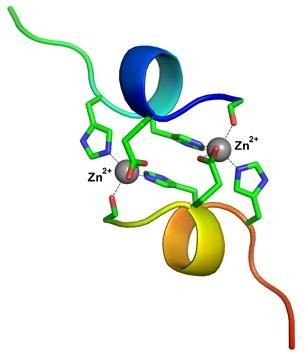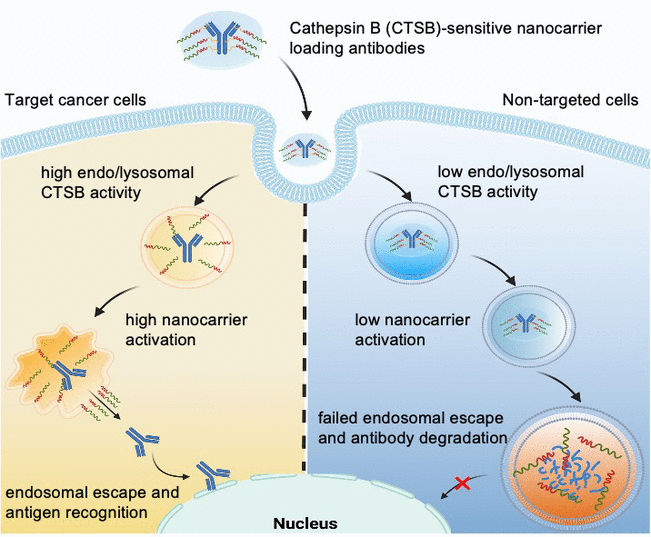Peptide complex formed in the brain is responsible for Alzheimer's disease
Members of the Faculty of Fundamental medicine at the Lomonosov Moscow State University have determined the structure of a peptide complex, formed in the brain at the early stages of Alzheimer's disease progression. The research results will contribute to the rational design of compounds, capable to block disease progress.

The structure of the complex of β-amyloid fragment -- the product of Taiwanese mutation, with zinc ions.
Vladimir Polshakov
Alzheimer's disease is associated with the aggregation of amyloid-β peptide in the human brain. The scientific team from the Lomonosov Moscow State University under the leadership of Vladimir Polshakov, Doctor of Chemistry, has studied molecular mechanisms of β-amyloid aggregation among the carriers of pathogenic familial Taiwanese mutation, described the structure of emerging complexes and established the role of zinc ions (Zn2+) in their formation.
β-Amyloid is a small peptide, implementing important physiological functions, for instance, protecting the brain from potential pathogenic agents. Normally, after fulfilling its functions the peptide is cleaved by proteases and utilized. However, in some cases molecules of this peptide start binding with each other, forming complexes toxic for neurons. Processes of β-amyloid aggregation into such complexes are initiated by transition metal ions.
During several years the scientists from the Lomonosov Moscow State University in cooperation with their colleagues from the Engelhardt Institute of Molecular Biology have been studied the molecular mechanism of zinc-mediated aggregation of β-amyloid peptide. They have chosen the peptide carrying the Taiwanese mutation as a model. Alzheimer's disease inevitably progresses among the carriers of such mutations at a relatively young age. The researchers have revealed that the structure of the β-amyloid complexes, consisting of mutant peptides, turns out to be tighter and more stable compared to the complexes from native peptides. Zinc ions (Zn2+) play the key role in their formation.
Vladimir Polshakov comments: "We were surprised to see that interaction between a fragment of this peptide and zinc ions has led to formation of a stable complex, where two peptide chains are tightly fastened by two zinc ions. Similar binuclear structures haven't been described in the literature yet. It's important to notice that interaction between metal ions and β;-amyloid peptides usually leads to the variety of peptide chain conformations. The emerging complexes are sort of "breathing", passing from one conformation to another. But in case of the peptide - product of Taiwanese mutation we observed the only single conformation, which allowed us to determine its structure with high accuracy and precision, using the methods of nuclear magnetic resonance spectroscopy."
The obtained results will help to design compounds, capable to block zinc-mediated β-amyloid aggregation, which, in its turn, would stop the progress of Alzheimer's disease at early stages. Vladimir Polshakov shares with the research perspectives: "Using the information on the molecular mechanism, revealed in this project, which initiates pathogenic aggregation of β-amyloid peptide, our colleagues from the Engelhardt Institute of Molecular Biology have already taken out patents for two compounds, capable of terminating β-amyloid aggregation. Studies of properties of these compounds on animal models have proved that they are able to reduce by several times the risk of progress of a disease, analogous to Alzheimer's disease in human."
The members of the Laboratory of Magnetic Tomography and Spectroscopy, working at the Faculty of Fundamental Medicine, the Lomonosov Moscow State University have conducted the research in tight collaboration with the scientific team from the Engelhardt Institute of Molecular Biology (Russian Academy of Sciences) under the guidance of Academician Alexander Makarov.
Original publication
Vladimir I. Polshakov, Alexey B. Mantsyzov, Sergey A. Kozin, Alexei A. Adzhubei, Sergey S. Zhokhov, Wouter van Beek, Alexandra A. Kulikova, Maria I. Indeykina, Vladimir A. Mitkevich, Alexander A. Makarov; "A Binuclear Zinc Interaction Fold Discovered in the Homodimer of Alzheimer's Amyloid‐β Fragment with Taiwanese Mutation D7H"; Angew. Chem. Int. Ed.; 2017
Most read news
Original publication
Vladimir I. Polshakov, Alexey B. Mantsyzov, Sergey A. Kozin, Alexei A. Adzhubei, Sergey S. Zhokhov, Wouter van Beek, Alexandra A. Kulikova, Maria I. Indeykina, Vladimir A. Mitkevich, Alexander A. Makarov; "A Binuclear Zinc Interaction Fold Discovered in the Homodimer of Alzheimer's Amyloid‐β Fragment with Taiwanese Mutation D7H"; Angew. Chem. Int. Ed.; 2017
Topics
Organizations
Other news from the department science

Get the life science industry in your inbox
By submitting this form you agree that LUMITOS AG will send you the newsletter(s) selected above by email. Your data will not be passed on to third parties. Your data will be stored and processed in accordance with our data protection regulations. LUMITOS may contact you by email for the purpose of advertising or market and opinion surveys. You can revoke your consent at any time without giving reasons to LUMITOS AG, Ernst-Augustin-Str. 2, 12489 Berlin, Germany or by e-mail at revoke@lumitos.com with effect for the future. In addition, each email contains a link to unsubscribe from the corresponding newsletter.
Most read news
More news from our other portals
Last viewed contents

Antibiotic resistances spread faster than so far thought - Resistance genes hop around the genome
Category:Phototrophic_bacteria

Bacterial cells can tell the time - Chronobiologists report that soil bacteria possess an internal clock

Atomic map of malaria drug gives it new life
Darius_Goes_West

ZEISS to acquire LENSO Sp. z o.o. to strengthen market access and industry expertise in 3D metrology and inspection solutions in Poland

Nanocarrier with Escape Reflex - Tumor-specific drug release through controlled endosomal escape
Mondor's_disease

Newly developed COVID vaccine from Austria could protect against omicron and other variants - Vaccine developed at MedUni Vienna delivers promising data
National_Childbirth_Trust
American_Psychological_Association






















































